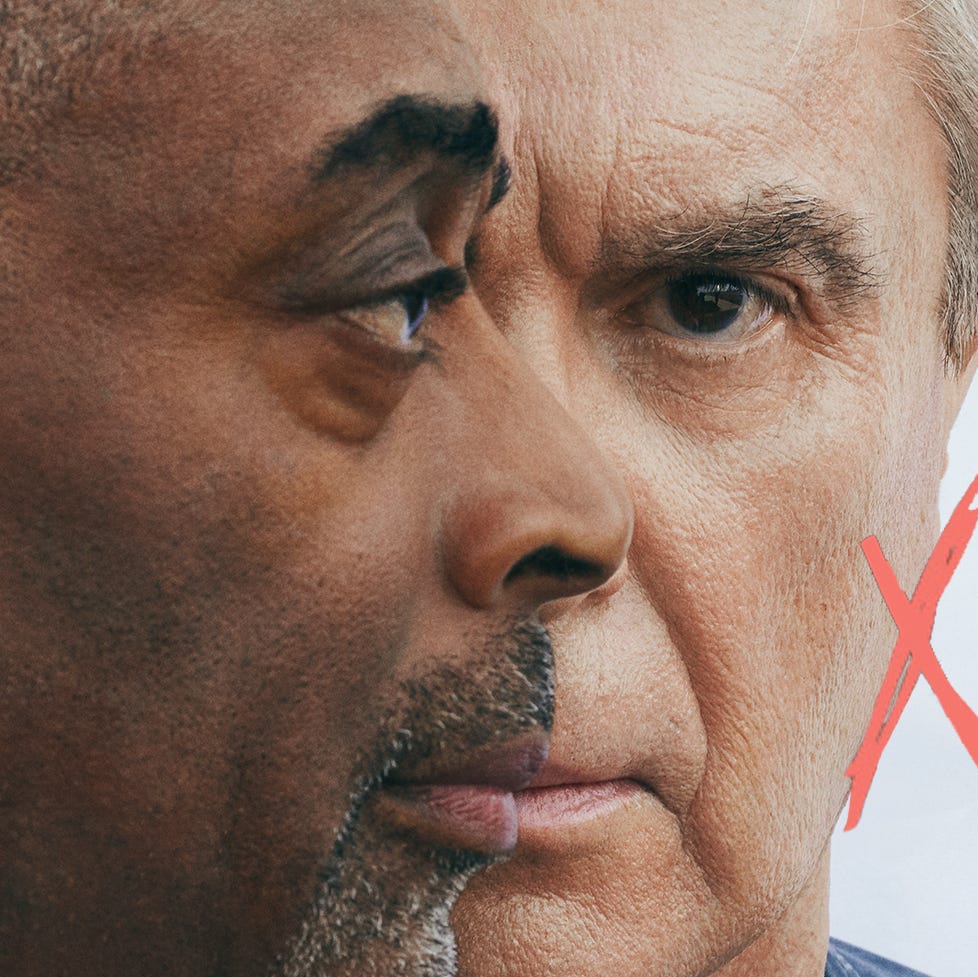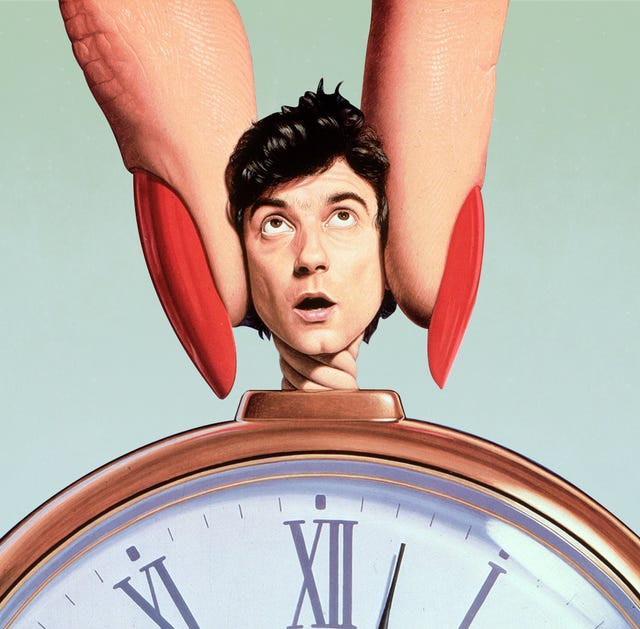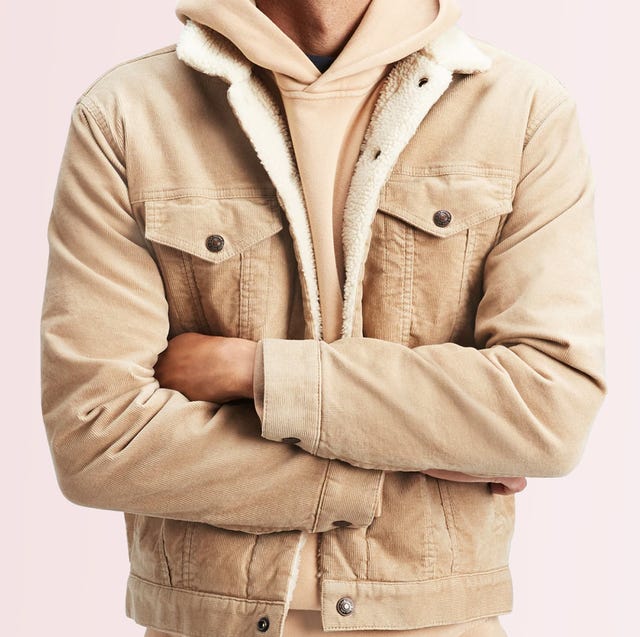 Cover Story: David Byrne, Spike Lee, and Some Wisdom for Right Now David Byrne's American Utopia begins with the sound of birds for close to a minute before revealing the singer, seated alone at a desk, holding a human brain. Otherwise, the stage is empty, save for a curtain composed of hundreds of thin metal chains that line the walls and shimmer like streaks of rain. As in Stop Making Sense, the 1984 Talking Heads concert film, band members emerge as the show progresses. They, like Byrne, are dressed in gray suits, with no shoes, no socks. It's a stripped-down look for a show that is as cerebral and subtly political as it is raucous and joyful. Byrne wrote or cowrote almost every song in it—a few are from his 2018 album of the same name, and about half are familiar Talking Heads tunes, including a version of "Once in a Lifetime" that's somehow even more poignant than the original. But it's a cover of Janelle Monáe's "Hell You Talmbout," one of American Utopia's last songs, that becomes its soul. In between, Byrne muses, philosophically and humorously, on whether babies are smarter than grown-ups and why people are more interesting to look at than, say, a bag of potato chips.
In the summer of 2019, before the start of the show's run on Broadway, Byrne had the idea to adapt it for the screen. He invited Spike Lee, whom he'd been friendly with for years, to attend previews, then asked whether he'd like to direct. Lee loved the show—and the idea. The result, which comes out on HBO in mid-October, is not a glorified theatrical recording. It's a real film.
It's also their first collaboration. Although both made a name for themselves in New York, Lee, who's sixty-three, came along a few years after Byrne, who's sixty-eight. The year Lee shot his first short film, 1977, is the same one that Talking Heads, the new-wave band Byrne fronted that made him famous, released their debut LP. (It was called, wait for it . . . 77.) By then, Byrne—handsome, tall like an antenna, and a bit shy—was a regular on downtown New York's music scene. Andy Warhol was a fan. Talking Heads had premiered live two years earlier, on the beer-soaked stage of CBGB, opening for punk pioneers the Ramones. By the time Lee released his first feature, She's Gotta Have It, in 1986, the band had banked six albums and six Billboard Hot 100 singles, and Byrne had become the unlikeliest of rock stars.
"Both of us, we have longevity," Lee says. Sure, he and Byrne have produced their share of clunkers over the years. But that's the price of the quality that unifies and perhaps defines them: creative evolution. BlacKkKlansman (2018) and Da Five Bloods (2020) are as electric as any other Spike Lee joint. As for Byrne, he collaborated on one of the best concert films of all time (1984's Stop Making Sense, directed by Jonathan Demme), launched a music label that releases recordings from musicians around the world (Luaka Bop), wrote two books (2009's Bicycle Diaries and 2012's How Music Works), and recently started a website. American Utopia, his second musical, was a hit from the start, and it was slated to return in the fall before the pandemic shut off the lights on Broadway. In the final week of its initial run, the show set the theater's box-office record for weekly earnings—$1.4 million. Consistency isn't why Byrne is still relevant; it's his constant transformation. "What I dig about David's act is: He's not going to do the same thing twice," Lee says. "Take a risk and not just do what's safe." Right back at you, Spike.
In early September, Esquire spoke with them over Zoom about the film, their personal growth, and life in 2020. Byrne was in his apartment in the Chelsea neighborhood of Manhattan, a beer in hand. Lee was at his Martha's Vineyard home, where a Kehinde Wiley painting adorned the wall behind him.  How After Hours Saved Martin Scorsese's Career, 35 Years Ago This Week Scorsese was just 41 at the time it all happened. Two consecutive flops made him start to believe that maybe he was all washed up. Or, if not washed up, then certainly in some nightmarish maximum-security wing of Director's Jail. With no new offers from the big studios forthcoming, Scorsese quickly realized that it was time to get back to his low-budget indie roots and get a movie going fast. Something small and personal that no one could lose a lot of money on. Something that would make being a director fun again. The movie that would emerge from that dark, winter-of-the-soul period would turn out to be 1985's After Hours—a deliriously tense and twisted comedy that remains one of his most under-appreciated films to this day. Chris Nashawaty remembers this pivotal point in the legendary director's career. Your Fall Style Secret Weapon Is a Shearling Jacket. These Are Our Favorites. Stylish dudes—some of 'em famous!—tend to really mess with the sherpa jacket. It's just one of those things. And it's easy to see why. Sherpa is a fabric typically made out of a heavily piled polyester, the type that gives the material its distinctive fluffy look. The overall effect is similar to real wool, though significantly less bulky. (It's also cheaper to produce.) Sure, the most common style you'll see the fabric used in is the classic trucker, but these days you can scoop a sherpa-lined anything. That's why we rounded up 15 our our favorites right now. There Has Never Been a Better Time to Own a Truly Great Robe If, for some reason, you've been intentionally avoiding the comfiest garment known to man, allow us to introduce you to the best possible thing you can do for your cold, trembling body—and, frankly, the worst possible thing you can do for your chances of ever leaving the house—this fall. Because once you wrap yourself in one of these bad boys you're never going to want to take it off. Cuffing season is fast approaching and that means one thing and one thing only: It's time to hole up at home in your fluffiest bathrobe and do nothing but binge watch terrible TV, gorging yourself on last-night's microwaved pizza while swaddled in a robe so soft it could make a grown man cry. Sure, wearing a robe full-time epitomizes what we like to call the cozy boy lifestyle, but it's also a downright regal move that should always make you feel like you're the king of your own—small, slightly shabby—castle. Here are 18 we are loving right now. Hillbilly Elegy and the Problem With Pop Culture's Appalachian Caricature Esquire's Justin Kirkland, a native of Tennessee, felt unsettled on Wednesday morning, when the long-awaited trailer for Netflix's Hillbilly Elegy dropped online. The film, adapted from J.D. Vance's New York Times best-selling memoir, is directed by Ron Howard and written by Vanessa Taylor (The Shape of Water, Game of Thrones). It stars Glenn Close and Amy Adams. At first glance, it appears to be real mad lib of an Oscar-bait film. Set in the town of Middletown, Ohio, the Appalachian narrative feels, at first, like a unique one worth celebrating. But after watching the trailer, having already read the book, it's obvious that, much like the source material itself, this could end up another portrait of an outsider's Appalachia: a marketable caricature of a proud community of people. An embarrassment worth paying attention to. Here, Kirkland reflects on the original sin of the memoir, and why it looks like it will be continued in the film. Join Our Club. We'll Send You Something in the Mail. (It's a Magazine.) But it's not just a magazine. With a membership to Esquire Select, the aforementioned club, you get unlimited access to Esquire.com, including The Politics Blog with Charles P. Pierce. You get a monthly discount to some of our editors' favorite brands. You get a members-only, weekly newsletter highlighting the best of Esquire right now. And, if you act fast, there might even be a free gift in it for you.
|







No comments:
Post a Comment